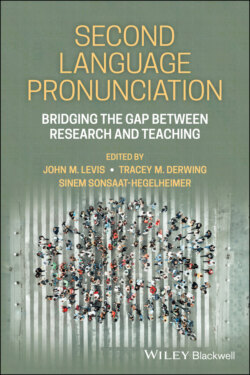Читать книгу Second Language Pronunciation - Группа авторов - Страница 24
Researching Pronunciation Integration: Moving the Field Forward
ОглавлениеWe know that teaching pronunciation in any form almost invariably leads to improvement in accuracy (Lee et al., 2015; Thomson & Derwing, 2015), especially in the short term, but we have little knowledge of how different ways of teaching pronunciation result in different outcomes. This is especially true in documenting the effects of approaches that integrate pronunciation into the classroom, both for specific features (e.g., Levis & Muller Levis, 2018) and for more general approaches that prioritize pronunciation as part of global speaking and listening skills (Derwing et al., 1998; Zhang & Yuan, 2020). Effectively integrating pronunciation with other areas of language instruction may serve as a “value-added” factor in language instruction (Pennington & Rogerson-Revell, 2019); that is, it may serve to show learners that other L2 language skills improve more when integrated with improved pronunciation skills. This section will describe possible ways to research the integration of pronunciation so that we better understand how integrating pronunciation affects teacher confidence, student communicative success, and effective materials development. Such research may show that pronunciation integration leads to better comprehensibility and intelligibility, that it leads to equal or greater improvement than teaching pronunciation alone, and it may demonstrate the best ways to integrate pronunciation.
There are few studies on the effectiveness of integrating pronunciation with other aspects of language teaching. This means that this is a largely unexplored area with great importance for the overall effectiveness of classroom language teaching. Like all instructional studies, ensuring that instructional contexts are as similar as possible is a challenging task. The ideas in Table 2.2 all have in common two (or more) classes in which the instructional focus differs in how pronunciation is addressed. Details of effective research practices are not addressed, but they can be found in Munro and Derwing (2020).
Table 2.2 Ideas for researching pronunciation integration.
| Research Goals | Class 1 | Class 2 |
|---|---|---|
| What happens when teaching the same pronunciation features in different ways? | Pronunciation features (PF) taught as stand-alone features in parallel to Listening/Speaking (L/S) instruction | Same PFs integrated so the features are explicitly connected to L/S instruction |
| Is there a difference between reactive and proactive pronunciation instruction? | No focus on PF outside of what teachers normally do (with particular features targeted) | PFs proactively integrated into L/S instruction (with particular features targeted) |
| Does the type of integration result in different outcomes? | Integration of PFs is done as an add-on, with work on particular PFs as another activity among many (as in integrated skills textbooks). | Integration of particular PFs is fully integrated into other parts of teaching. |
| Is the teaching of PFs relevant to the overall topic more effective than teaching irrelevant PFs? | Teach PFs that are largely irrelevant for topic (e.g., vowels for spoken fluency) | Teach PFs that are relevant to topic (e.g., thought groups for spoken fluency) |
| Does the integration of PFs into a reading class lead to better reading outcomes (e.g., for phonemic awareness)? | Teach reading without addressing PFs | Teach reading while addressing PFs |
| Does the intensity of integration make a difference in outcomes? | Integrate a modest amount each day during the term. | Integrate intensively during the first several weeks, then as needed. |
| What is the effect of explanation vs. practice? | Integrate with explanation only in class. Practice via optional homework. (Variant: Explain with optional homework) | Integrate with explanations and with class practice. (Variant: Explain with required homework) |
| What is the effect of integrating different PFs into instruction? | Integrate one or more PFs or aspects of PFs (e.g., Prominence signaling New information) | Integrate other PFs (e.g., Prominence signaling contrasts) |
